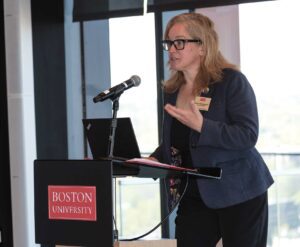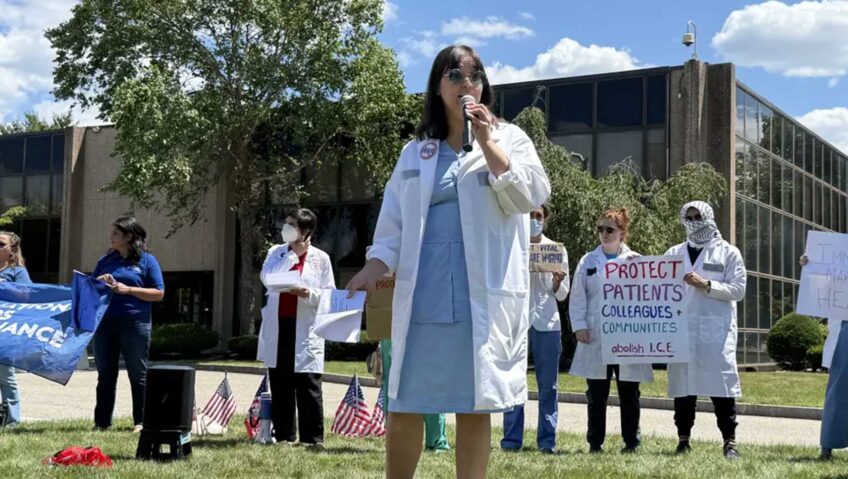
A new database aims to shine more light on how energy infrastructure impacts public health, including the disproportionate impact on communities of color.
The database, launched last week by Boston University’s Institute for Global Sustainability, gathers, for the first time, disparate sources of federal information about the location of energy infrastructure into one location.
Preliminary research from the Energy Infrastructure Exposure Intensity and Equity Indices (EI3) found that exposure to energy infrastructure in the United States is extensive: Over 90% of census tracts are within a health-relevant distance of facilities like power plants, refineries, tank farms, pipelines, gas compressor stations or green energy generators.
But when it comes to infrastructure most damaging to human health — facilities that process and/or combust fossil fuels — it is five times more likely to be located in census tracts predominantly populated by people of color.
The dataset also looks to fill gaps from the middle of the chain of production and distribution, both for fossil fuels and renewable energy infrastructure. For example, currently there’s clear information about the health impacts of production and the final steps as fossil fuels are used, but the effects of many of the middle steps around how natural gas is processed and distributed remain unclear.

Rebecca Pearl-Martinez, executive director of the BU Institute for Global Sustainability, welcomes attendees to the institute’s Power and People Symposium May 7. BANNER PHOTO
“There’s this whole suite of things in the middle where … we know that there’s gas, we know there might be hazards for folks, but that’s all we know. Exposure has not been assessed and we don’t know how bad it is,” said Jonathan Buonocore, a BU professor of environmental health and faculty member with the Institute for Global Sustainability, who co-led the project.
All the information in the dataset is publicly available, mostly gathered from federal agencies like the Department of Homeland Security, the U.S. Energy Information Administration and the Environmental Protection Agency, but Buonocore said the new EI3 database is the first time that he’s aware of all the information being compiled in one place, a change that might allow for more comprehensive research on how energy infrastructure impacts health.
Buonocore said he hopes that the new dataset could prove useful to community groups and environmental justice organizations, and those groups seem to agree.
Information like what’s covered in the dataset can be in important tool in conversations around how impacts from different pieces of infrastructure impact health, said Devin MacGoy, the energy democracy community organizer at Chelsea- and East Boston-based Greenroots.
“Datasets like this are extraordinarily valuable when we’re starting to talk about cumulative impact, something that should have been talked about a long time ago, but it’s now part of state policy, and just hopefully going to be something included in EPA fairly soon,” he said.
The researchers also hope that the database can help illustrate, more concretely, why this infrastructure poses health concerns.
Matthew Tejada, senior vice president for environmental health at the Natural Resources Defense Council, said data like this can ground people and make abstract concepts more tangible, something he said is especially important as the country and the world face an energy revolution around how and where energy is made and used.
“That sort of data can cut through the noise,” Tejada said during his keynote address at the symposium. “It can help communities understand where they are and where they might be going and it’ll allow advocates, decision makers and academicians to engage in a conversation grounded in the reality that communities are experiencing and allow us to ask much better questions and come up with much better answers.
Fights around the location of energy infrastructure — and the potential effects they could have on low-income communities and communities of color in the Boston area — are longstanding.
In East Boston, community-based organizations like Greenroots have fought against the siting of an Eversource substation near a park and playground. Nearby, oil tank farms, used to store petroleum products, line Chelsea Creek.
Historically, in the 1970s and 1980s, the Mission Hill community fought — ultimately unsuccessfully — the launch of the Medical Area Total Energy Plant which now powers hospitals in the Longwood Medical Area as well as Harvard’s medical and public health schools.
Though the new database offers a more comprehensive look at energy infrastructure than has been previously available, gaps still exist. For example, information about the specific location around the path of natural gas and oil pipelines is obscured by the federal government for security reasons, which can make it challenging to attach potential health effects caused by that infrastructure.

Zeyneb Magavi, co-executive director of the nonprofit HEET, speaks at a panel discussion on potential co-benefits of energy infrastructure. BANNER PHOTO
“You start zooming in the pipelines start looking very suspiciously straight. You zoom in a little bit further, they just disappear,” Buonocore said. “So we don’t have the locations for those in the data set. We can know where the pipelines are within a few miles, but that’s the best we can do.”
Even for residents who might live near pipelines, finding that information is tough, if not impossible.
“From a basic environmental justice perspective, people aren’t necessarily able to look up ‘Do you live near a pipeline?’ if that’s something that occurs to you. Maybe you can go in your backyard and look around, but besides that, it’s really unclear in most places,” said Mary Willis, a BU professor of epidemiology and Institute for Global Sustainability faculty member who co-led the project with Buonocore.
For now, drawing clear lines from the information collected in the database to health impacts remains challenging. The communities most likely to be affected by energy infrastructure tend to face overlapping concerns to their physical wellbeing from other sources that leave clear lines of cause to effect hard to identify.
“With energy infrastructure, we don’t necessarily always know what’s coming out of it,” Willis said. “If all we know is that you were 1.6 kilometers from a compressor station and you had an asthma attack, we can make some assumptions and say, ‘Hey, there’s an association between people living near these sites and adverse asthma outcomes,’ but we can’t really say that X causes Y.”
With more research, those links could be shown, but it would require more information about when pieces of infrastructure were proposed and constructed. Beyond that, identifying health impacts could be better supported if there were more comprehensive information about what chemicals and particles are being emitted by different pieces of infrastructure.
Being able to draw those links is one piece on a “long wish list” of next steps the team has for the project, which includes filling in some of the gaps in the data and expanding the scale to look globally.






